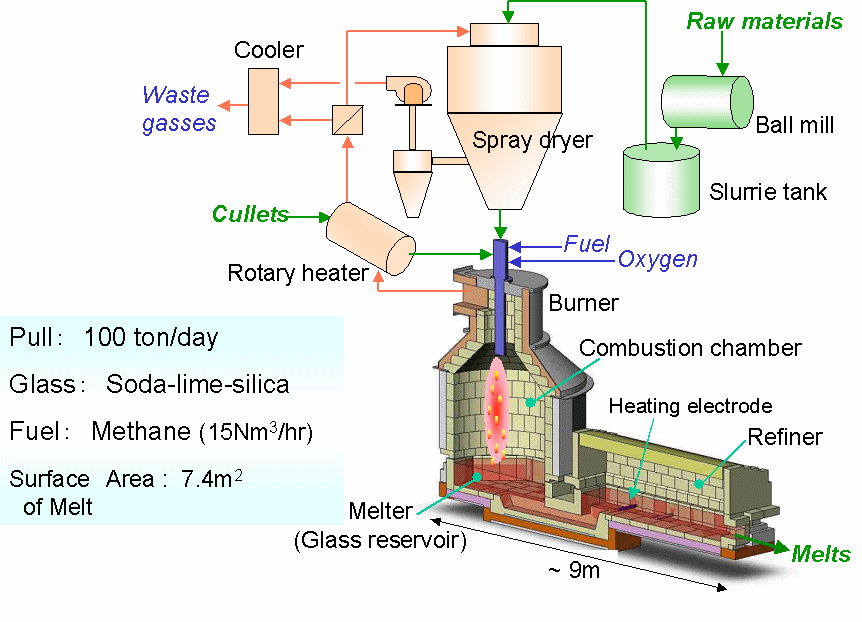| A. Technology for In-flight Melting of Glass Raw Materials 1) With the improvement of the in-flight melter and the burner design, it is confirmed that the 1t/d test furnace can be operated with the 955 kcal/kg-glass specific melting energy consumption. The granulated batch for green glass is successfully melted. 2) Strong granules of borosilicate glass for LCD were produced by means of a large scale spray drying process. It was successfully in-flight melted by means of oxy/gas burner without interruption due to the growth of bubble layer. Minimum specific energy consumption for melting was 2,400 kcal/kg-glass. 3) A 12-phase AC arc with an oxygen burner was developed to apply in glass in-flight melting. The erosion rate of the electrodes was less than 20 mg/min. The measurements for the electrode temperature by a high-speed video camera and band-pass filters indicated the electrode tip temperature and a molten area of electrode surface were influenced by number of the phases. 4) In order to investigate the possibility/advantage of the in-flight melting for specialty glass, a composition with a CaO-Al2O3-SiO2 system was selected. Strong granules could be obtained and successfully melted by using RF plasma. A glass block with little bubbles was obtained in the pre-heated Pt crucible kept at high temperature. 5) Decrease of the residual bubbles in the in-flight melted soda-lime-silica glasses prepared using a 1t/d melter were confirmed by remelting, and the contained gas species changed from CO2+COS to N2+CO2 as major constituents. In-flight melting behavior in the combustion burner flames were also captured and analyzed by IR camera. Dissolved gas analysis showed the release of H2O, CO2 and SO2 from the glass. 6) A time-dependant simulation program to describe the foam layer growth and dissolution was developed as a prototype model. The pre-post program was much improved in connection with the input of computation data, the execution of calculation and the graphical output of the results. B. Highly Effective Heating Technology for Cullet. Using 200um cullet, the in-flight melter could be operated with the specific melting energy consumption 1,080 kcal/kg-glass. The cullet with the granulated batch of 50 wt% or 10 wt% was successfully melted. C. High Speed Mixing Technology of Melts of Raw Materials and Cullet. 1) It is confirmed, using 1 pair of the screw type stirrer with 20 rpm, stirring time less than 3 hrs, the obtained glass has same homogeneity level as the commercial container glass. 2) The homogeneity of the glasses fabricated by the 1t/d in-flight melter was evaluated. The glasses kept the standard deviation values corresponding to the container glass homogeneity after the reduction of energy consumption rate to 1,071 kcal/kg-glass. |
 |